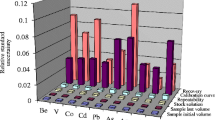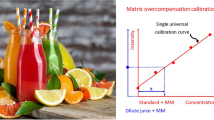Abstract
Throughout the US Food and Drug Administration’s routine monitoring of various juice samples for elemental contaminants, a limited number of samples exhibited unexpected behavior related to the arsenic content. Juice samples were subjected to total arsenic determination and those containing arsenic > 10 μg kg−1 were subjected to arsenic speciation analysis using FDA Elemental Analysis Manual (EAM) 4.10 method (AOAC First Action Method 2016.04) to determine the concentration of iAs and other common organic arsenicals. For a subset of samples, the sum of the arsenic species was significantly less than the total arsenic value (i.e., mass balance < 65%), which is uncommon for a liquid-based matrix. Juice types that have exhibited this behavior include pomegranate, prune, and cherry juices. Causes for this issue were explored which ultimately led to an alternate sample preparation technique, extraction with 0.28 M HNO3 along with heat, which resulted in drastically improved mass balances approaching 100%. The method proved robust, with both accurate and precise measurements for multiple juice samples analyzed by a total of four laboratories. Two laboratories performed a level 3 multilaboratory validation. This work discusses various issues that were encountered, attempts to determine the source of the problem, the eventual solution in the form of a modified extraction procedure, and the multilaboratory validation results.




Similar content being viewed by others
References
Banerjee M, Bhattacharjee P, Giri AK (2011) Arsenic-induced cancers: a review with special reference to gene, environment and their interaction. Genes Environ 33:128–140. https://doi.org/10.3123/jemsge.33.128
Chen Y, Reddy RM, McLaughlin MA, Al-Taher F, Yettella RR, Uhlig S, Bläul C (2014) Method validation and proficiency testing for determination of total arsenic in apple juice by inductively coupled plasma/mass spectrometry. J AOAC Int 97:1143–1150. https://doi.org/10.5740/jaoacint.13-207
Clough R, Harrington CF, Hill SJ, Madrid Y, Tyson JF (2016) Atomic spectrometry update: review of advances in elemental speciation. J Anal At Spectrom 31:1330–1373. https://doi.org/10.1039/C6JA90030E
Coelho NMM, Coelho LM, Lima ES, Pastor A, Guardia M (2005) Determination of arsenic compounds in beverages by high-performance liquid chromatography-inductively coupled plasma mass spectrometry. Talanta 66:818–822. https://doi.org/10.1016/j.talanta.2004.11.037
Conklin SD, Chen PE (2012) Quantification of four arsenic species in fruit juices by ion-chromatography-inductively coupled plasma-mass spectrometry. Food Addit Contam, Part A 29:1272–1279. https://doi.org/10.1080/19440049.2012.687775
Conklin SD, Kubachka KM, Shockey NV (2013) High performance liquid chromatography-inductively coupled plasma-mass spectrometric determination of four arsenic species in fruit juice, Version 1.0. U.S. Food and Drug Administration
Cunningham WC, Mindak WR, Capar SG (2014) Terminology. U.S. Food and Drug Administration
Dewi F, Sim LP, Wang J, Tong BMK, Shin RYC, Lee TK (2016) Development of an apple juice certified reference material for cadmium, lead, total arsenic and arsenic species. Int J Mass Spectrom 411:14–20. https://doi.org/10.1016/j.ijms.2016.11.001
Ellingson D, Zywicki R, Sullivan D (2014) Analytical method for the determination of various arsenic species in rice, rice food products, apple juice, and other juices by ion chromatography-inductively coupled plasma/mass spectrometry. J AOAC Int 97:1670–1681. https://doi.org/10.5740/jaoacint.14-047
Food and Drug Administration (2013) Draft guidance for industry: Action level for Arsenic in Apple Juice https://www.fda.gov/regulatory-information/search-fda-guidance-documents/draft-guidance-industry-action-level-arsenic-apple-juice. Accessed 9/16/19
Food and Drug Administration, Guidelines for the Validation of Chemical Methods for the FDA FVM Program (2015) 2nd edn
Gray PJ, Mindak WR, Cheng J (2015) Inductively coupled plasma-mass spectrometric determination of arsenic, cadmium, chromium, lead, mercury, and other elements in food using microwave assisted digestion version 1.1. U.S. Food and Drug Administration
Huang J-H, Ilgen G, Fecher P (2010) Quantitative chemical extraction for arsenic speciation in rice grains. J Anal At Spectrom 25:800–802. https://doi.org/10.1039/c002306j
IARC Working Group on the Evaluation of Carcinogenic Risks to Humans (2004) Some drinking water disinfectants and contaminants including arsenic. IARC Monogr Eval Carcinog Risks Hum 84:1-477
Kubachka KM, Heitkemper DT, Conklin SD (2017) Multilaboratory validation of first action method 2016.04 for determination of four arsenic species in fruit juice by high-performance liquid chromatography-inductively coupled plasma-mass spectrometry. J AOAC Int 100:1077–1085. https://doi.org/10.5740/jaoacint.16-0429
Kubachka KM, Shockey NV, Hanley TA, Conklin SD, Heitkemper DT (2015) Arsenic speciation in rice and rice products using high performance liquid chromatography-inductively coupled plasma-mass spectrometric determination. U.S. Food and Drug Administration,
Larsen EH, Sturup S (1994) Carbon-enhanced inductively coupled plasma mass spectrometric detection of arsenic and selenium and its application to arsenic speciation. J Anal At Spectrom 9:1099–1105. https://doi.org/10.1039/JA9940901099
Lee C-H, Yu H-S (2016) Role of mitochondria, ROS, and DNA damage in arsenic induced carcinogenesis. Front Biosci (Schol Ed) 8:312–320
Mantha M, Yeary E, Trent J, Creed PA, Kubachka KM, Hanley TA, Shockey NV, Heitkemper DT, Caruso AJ, Xue J, Rice G, Wymer L, Creed JT (2017) Estimating inorganic arsenic exposure from U.S. rice and total water intakes. Environ Health Perspect 125:057005
Narukawa T, Iwai T, Chiba K (2018) Determination of inorganic arsenic in grape products using HPLC-ICP-MS. Anal Sci 34:687–691
Roberge J, Abalos AT, Skinner JM, Kopplin M, Harris RB (2009) Presence of arsenic in commercial beverages. Am J Environ Sci 5:688–694. https://doi.org/10.3844/ajessp.2009.688.694
Total Diet Study. FDA. https://www.fda.gov/Food/FoodScienceResearch/TotalDietStudy/. Accessed 9/10/18 2018
Wallschlager D, Stadey CJ (2007) Determination of (oxy) thioarsenates in sulfidic waters. Anal Chem 79:3873–3880
Wang Z, Nadeau L, Sparling M, Forsyth D (2015) Determination of arsenic species in fruit juice and fruit drink products using ion pair chromatography coupled to inductively coupled plasma mass spectrometry. Food Anal Methods 8:173–179. https://doi.org/10.1007/s12161-014-9888-5
Acknowledgments
The authors would like to thank the analysts from the FDA laboratories that analyzed the samples as part of the multilaboratory study, Miranda McDonald from the Kansas City Lab Laboratory, in Lenexa, KS, as well as Christina Qiu from the San Francisco Laboratory, in Alameda, CA. Additionally, the authors would like to thank Diana Mould from the Southeast Food and Feed Laboratory for data regarding pomegranate juice samples analyzed utilizing the extraction method.
Author information
Authors and Affiliations
Corresponding author
Ethics declarations
Disclaimer
The views expressed in this article are those of the authors and do not necessarily reflect the views or policies of the US Food and Drug Administration. Mention of trade names or commercial products does not constitute endorsement or recommendation for use.
Conflict of Interest
Kevin M. Kubachka declares that he has no conflict of interest. Sean D. Conklin declares that he has no conflict of interest. Cynthia Smith declares that she has no conflict of interest. Consuelo Castro declares that she has no conflict of interest.
Ethical Approval
This article does not contain any studies with human participants or animals performed by any of the authors.
Informed Consent
Not applicable
Additional information
Publisher’s Note
Springer Nature remains neutral with regard to jurisdictional claims in published maps and institutional affiliations.
Rights and permissions
About this article
Cite this article
Kubachka, K.M., Conklin, S.D., Smith, C.C. et al. Quantitative Determination of Arsenic Species from Fruit Juices Using Acidic Extraction with HPLC-ICPMS. Food Anal. Methods 12, 2845–2856 (2019). https://doi.org/10.1007/s12161-019-01636-y
Received:
Accepted:
Published:
Issue Date:
DOI: https://doi.org/10.1007/s12161-019-01636-y




